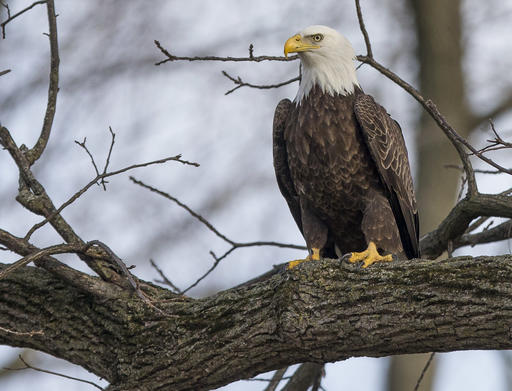Bald eagle pair highlight of Berlin Lake summer

By David Campana
Ohio certified volunteer naturalist
As a passive observer of our feathered friends, this has been a year of personal firsts.
It began this spring when a pair of pileated woodpeckers visited my backyard. Soon afterward, I found eastern kingbirds had nested on my Berlin Lake house trailer porch. Despite their aggressive reputation, they didn’t bother us when we sat nearby.
But the highlight came when we saw a pair of bald eagles (Haliaeetus leucocephalus) sitting on the lake’s shoreline.
The low, late-summer water level exposed the rocky shoreline, and two mature eagles (white head and tail feathers) were pecking at something among the rocks and sand.
In decades of boating on Berlin, I’ve probably noticed about a half-dozen eagles flying over. The only time I’ve seen them nesting or perching in our area was at the Mill Creek Wildlife Sanctuary in Canfield.
New and established pairs start nest-building between October and early December. The one to three eggs laid in late winter hatch between February and April after a 35-day incubation period. Both parents share egg-tending, then feeding duties. Chicks fledge after 10-13 weeks.
While pairs produce one brood per year, a destroyed nest may be rebuilt and a second clutch produced.
Actually, we’ve probably seen more bald eagles than we’ve recognized. While the white head and tail of our national symbol is familiar to every school-age and older American, it doesn’t develop this plumage until reaching maturity at 5-6 years old. Until then, they are covered head to tail in mottled, dark brown feathers.
From the 1940s until well after it was banned in 1972, the insecticide DDT wreaked havoc on raptor populations to the point that bald eagles were placed on the Federal Endangered Species list.
From a low point in 1979 when four nests in Ohio produced one fledgling each until 2017 when 221 nests produced 312 fledglings, the birds have enjoyed a steady and stabilized comeback in our state. It is no longer “endangered,” but remains under federal protection.
Highly territorial, the birds prefer secluded sites near marshes and rivers where ample fish are available within 2 miles of the nest. Bald eagles and ospreys are both fish-eaters and compete for resources.
A guide advised there are no ospreys at the wildlife sanctuary due to the larger bird’s aggression.
On larger bodies of water like Berlin with numerous ospreys, baldies are known to steal the other’s catch.
Perhaps the eagles we came upon were eating a fish pilfered from another bird.
To learn more about these and other wildlife species in Ohio, visit http://wildlife.ohiodnr.gov/species.
 43
43
